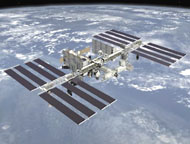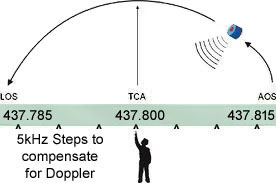Amateur Radio
International Space Station
On Board FM
Cross Band Repeater
Using CHIRP


John 'Miklor' K3NXU
Updated 6-20-2023
|
What is
ARISS
On Sept 2, 2020 a cross band FM amateur radio repeater was activated on the International Space Station
with a downlink on 437.800 MHz.
The Goal of this page
Being able to contact other amateur operators via
Satellite is another aspect of the amateur radio hobby.
This cross band FM repeater is located on the
International Space Station flying at an altitude of
410-440km (255-275 miles) above the Earth.
This is a 'starter' page with some of the basics,
references, and a CHIRP programming file. Searching the
internet for information on AMSAT and ARISS will provide
mega information on the topic.
Understanding Doppler
Setting up your radio requires a slight bit of knowledge
regarding Doppler shift. To summarize, when a signal is
coming from a fixed location, the frequency is constant.
However, when a signal is sent from a source that is
travelling toward or away from the receiving station at
a high rate of speed, the actual frequency can change
based on the speed and distance.
An
example is a car going passed at high
speed.
Note: ISS
- Orbital Speed - 27,600kph (17,100mph) (4.76mps)
- Orbital Period - 92.68 minutes
- Orbits per Day - 15.54
- Altitude - 410-440km (255-275 miles)
- Altitude Plot -
ISS Height
This explained in more detail at the following link in
these sections:
- Doppler and the voice UHF Crossband Repeater
- The Voice UHF REVERSE Crossband Repeater
The graphic below shows how the base frequency of
437.800MHz can shift based on the location and speed of the ISS.

AOS - Acquisition of
Signal
LOS - Loss of Signal |
Set up using CHIRP
Here is a link to a
CHIRP image file using the frequencies
described above. This layout allows you to receive
the UHF downlink and transmit on the VHF uplink using the
same radio.
Although the file
was created using a Baofeng UV82, the image can be cut/pasted into the image for your transceiver.
Download and Save the following CHIRP image file.
CHIRP_ARISS.img
Note: Windows may flag this file as an unfamiliar image
type (.img) Do not be concerned.
Here is a reference to the attached file. The frequency shift is shown in both transmit and receive.
Note that the Doppler shift on VHF is 1/3 that
of UHF.
When using CHIRP, setting the Duplex field to
'split' allows you to enter the transmit frequency
directly.
References
|
| |
|
|